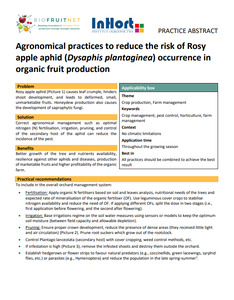{Tool} Agronomical practices to reduce the risk of Rosy apple aphid (Dysaphis plantaginea) occurrence in organic fruit production (Biofruitnet Practice Abstract). Creator(s): Piotrowski, Wojciech and Tartanus, Małgorzata. Issuing Organisation(s): IO-PIB - National Institute of Horticultural Research. Biofruitnet Practice Abstract, no. 021. (2022)
|
PDF
- English
(Agronomical practices to reduce the risk of Rosy apple aphid (Dysaphis plantaginea) occurrence in organic fruit production)
544kB | |
![[thumbnail of 2022-07-01 14_21_19-Agronomical practices to reduce the risk of Rosy apple aphid (Dysaphis plantagin.png]](/44229/3.hassmallThumbnailVersion/2022-07-01%2014_21_19-Agronomical%20practices%20to%20reduce%20the%20risk%20of%20Rosy%20apple%20aphid%20%28Dysaphis%20plantagin.png)  Preview |
Image (PNG)
- Cover Image
- English
102kB |
|
PDF
- Polish/Polski
(Praktyki agronomiczne ograniczające ryzyko wystąpienia mszycy jabłoniowo-babkowej (Dysaphis plantaginea) w ekologicznej produkcji owoców)
577kB |
Document available online at: https://orgprints.org/44229
Summary in the original language of the document
Better growth of the tree and nutrients availability, resilience against other aphids and diseases, production of marketable fruits and higher profitability of the organic farm.
Practical recommendations
To include in the overall orchard management system:
• Fertilisation: Apply organic N fertilisers based on soil and leaves analysis, nutritional needs of the trees and expected rate of mineralisation of the organic fertiliser (OF). Use leguminous cover crops to stabilise nitrogen availability and reduce the need of OF. If applying different OFs, split the dose in two stages (i.e., first application before flowering, and the second after flowering).
• Irrigation: Base irrigations regime on the soil water measures using sensors or models to keep the optimum soil moisture (between field capacity and allowable depletion).
• Pruning: Ensure proper crown development, reduce the presence of dense areas (they received little light and air circulation). Prune root suckers which grow out of the rootstock.
• Control Plantago lanceolata (secondary host) with cover cropping, weed control methods, etc.
• If infestation is high, remove the infested shoots and destroy them outside the orchard.
• Establish hedgerows or flower strips to favour natural predators (e.g., coccinellids, green lacewings, syrphid flies, etc.) or parasites (e.g., Hymenoptera) and reduce the population in the late spring-summer.
| EPrint Type: | Practice tool |
|---|---|
| What problem does the tool address?: | Rosy apple aphid causes leaf crumple, hinders shoot development, and leads to deformed, small, unmarketable fruits. Honeydew production also causes the development of saprophytic fungi. |
| What solution does the tool offer?: | Correct agronomical management such as optimal nitrogen (N) fertilisation, irrigation, pruning, and control of the secondary host of the aphid can reduce the incidence of the pest. |
| Country: | Poland |
| Type of Practice Tool: | Practice abstracts |
| Keywords: | Crop management, pest control, horticulture, farm management |
| Agrovoc keywords: | Language Value URI English crop management http://aims.fao.org/aos/agrovoc/c_16094 English pest control http://aims.fao.org/aos/agrovoc/c_5726 English horticulture http://aims.fao.org/aos/agrovoc/c_3671 English farm management http://aims.fao.org/aos/agrovoc/c_2799 |
| Subjects: | Crop husbandry > Production systems > Fruit and berries Crop husbandry > Crop health, quality, protection |
| Research affiliation: | European Union > Horizon 2020 > Biofruitnet Poland European Union > Organic Farm Knowledge |
| Horizon Europe or H2020 Grant Agreement Number: | 862850 |
| Related Links: | https://organic-farmknowledge.org/tool/44229, https://biofruitnet.eu, https://organic-farmknowledge.org/tool/44181, https://x.com/farm_knowledge/status/1803701558615351404, https://www.facebook.com/organicfarmknowledge/posts/pfbid0cvZTkhywbk2iM7oRxb9cV9GE2gAgtemxAe2PMVUcCMgVJJPJD8ZV9k4yUdY32HzJl |
| Project ID: | ofk |
| Deposited By: | Basler, Andreas |
| ID Code: | 44229 |
| Deposited On: | 29 Jun 2022 13:41 |
| Last Modified: | 20 Jun 2024 08:11 |
| Document Language: | English, Polish/Polski |
| Status: | Published |
Repository Staff Only: item control page

 Download Statistics
Download Statistics Download Statistics
Download Statistics
